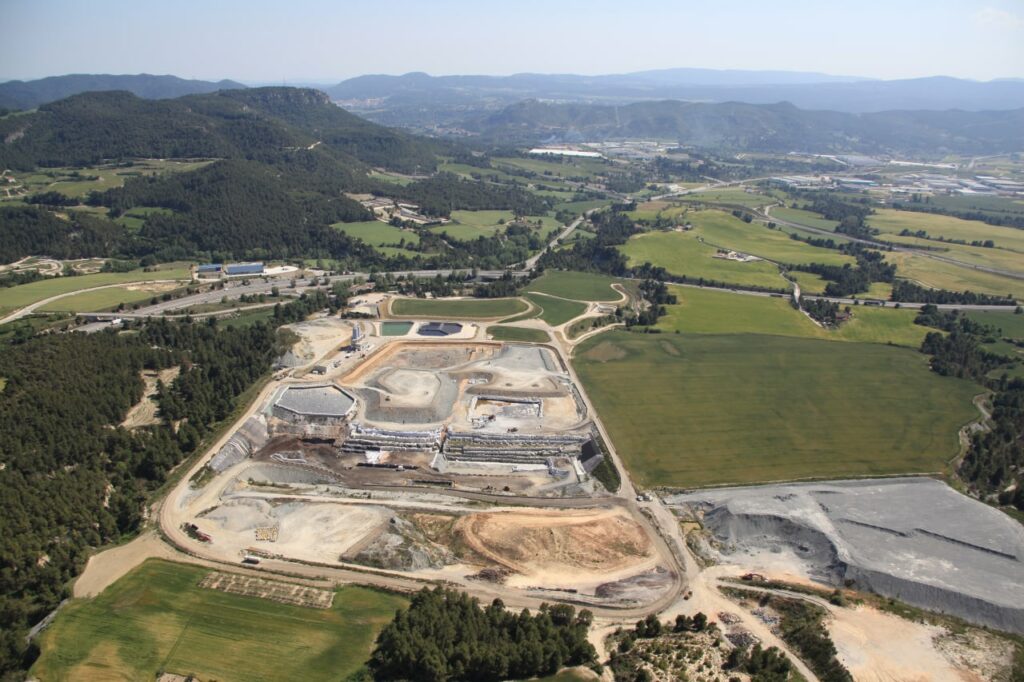Management and operation
Design and construction of hazardous waste storage facility
ATLAS designs, builds, and manages the Castellolí special waste warehouse. The purpose of this facility is the confinement and isolation from the environment of those special wastes whose treatment route is controlled disposal (D0503).
The construction, operation and post-closure control of the controlled reservoir is carried out under the strict regulatory framework in force in Catalonia, Spain and Europe, which requires the highest levels of control and quality of the facility.
The geological characteristics of the terrain, formed by a thick layer of sedimentary rock with a high clay content, give the land a high degree of natural impermeability.
The construction criteria, well above the current regulations, provide all the waterproofing and drainage of the bottom and sides of the tank, optimal conditions that improve the natural conditions of the site, and facilitate a modern and safe management of the installation, ensuring an optimal level of sealing of the waste, safeguarding and minimizing the risk at all times, of any possible impact on the environment.

Closed warehouses
There are 3 closed tanks at the facility that were once used for the disposal of industrial waste.
In 1996, the last of these warehouses was closed in accordance with applicable regulations. ATLAS currently performs maintenance and post-closure control tasks, as required by Decree 1/1997. These tasks will be carried out for a period of 15 years from the date of closure. However, as the activity is in operation, this control continues to be carried out.
The leachate area (leachate is the rainwater that falls into the tank and comes into contact with the waste) of the closed tanks consists of two basins, the north basin with a capacity of 348 m3 and the south basin with a capacity of 348 m3. The treatment of these leachates (reduction of Cr+6 to Cr+3) is carried out in the same facility, following the company’s internal procedure.
Single-Tank Hole 3
Deposit of waste in big bags for municipal waste incineration ashes and compatible waste.
This depot was closed at the end of 2010. Post-closure control of tasks and maintenance is currently being carried out.
The leachate area consists of two ponds of 670 and 123 m3 where leachate is collected and two ponds of 2,191 and 477 m3 capacity where mixed water, consisting of rainwater and possible excess leachate, is collected.
Expansion Zone
The total net capacity of the expansion area is 2,119,538 m3, as established in the environmental authorization for the center approved on April 19, 2002.
In the expansion, there are two types of tanks, with their own independent infrastructures: Tank A, where waste is deposited in streams (in units in the AF cell), and Tank B, where waste is deposited in big bags in an orderly fashion. Within Vessel A and B, there is a separate cell for fiber cement/asbestos waste, which has a specific protocol for the management and decontamination of personnel and transport.
The work to adapt the different phases of the reservoir is being carried out progressively as the operating cells are being decommissioned.
The leachate is collected separately in Vessel A and Vessel B, in two totally independent basins of 1,672 m3 capacity. In the same pond area, there is a third leachate and suppression water regulation pond with a capacity of 1,021 m3 (pond C).
In the same pond area, there is a pond with a useful volume of 6,366 m3 for operating rainwater, in the area of the expansion.
High density bagging plant
The high-density bagging plant treats, compacts, and bags municipal waste incineration ash with leachate from the landfill itself and collected rainwater.
The ashes are discharged from the tanker trucks that transport them to a storage silo with a hose filter. Subsequently, they are sent to a mixer where they are moistened so that they can be bagged in watertight and impermeable big-bags. Once the big-bag is full, it is pressed and transported to the tank vessel.
All leachates and operating rainwater generated in the different tanks of the facility are reused in the bagging plant, where they are incorporated into the incineration ash compaction process. In this way, the entire installation does not discharge any type of waste into public waterways.
